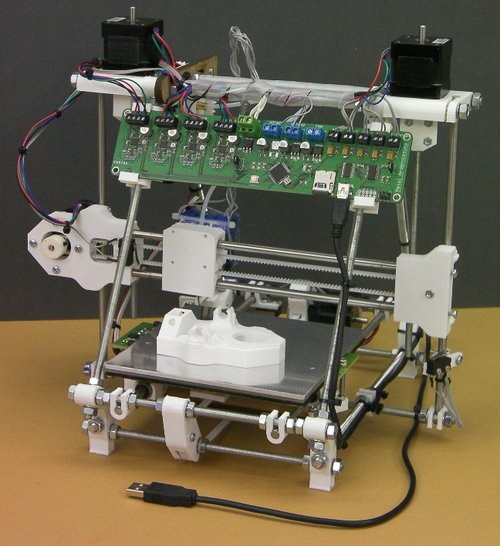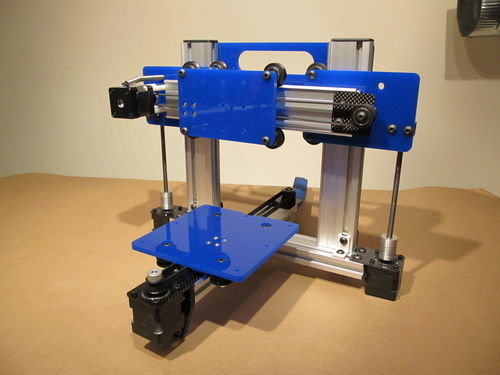Thu Feb 2 04:11:14 EST 2012
the state of the reprap field
I've been looking at RepRap derived 3D printers recently, and what I'm seeing is encouraging.
The basic idea of the RepRap project is to build a self REPlicating RAPid prototyping machine, in the vein of the von Neumann universal fabricator. This is, of course, very very hard to do; and the RepRap project is nowhere near achieving full closure, there are still a great many "vitamins", components needed for self replication that the printer can't make itself. (Exactly analogous to vitamins in the conventional sense: biomolecules required for life, which the body can't synthesize itself.)
I've been following RepRap for six years, and for the first five of those years, it hasn't been a very good bet.
A FDM 3D printer is exactly like a 2D inkjet printer, except with a Z axis, and with a hot glue gun instead of an ink printhead.
Those of you who are familiar with motion control hardware and plastics extrusion are currently feeling faint chills of foreboding, and indeed, this is a Hard Problem. The printer hot end needs to be able to extrude thousands of metres of filament without requiring maintenance, while still being made out of common materials, as well as being as light, (print speed is limited by how fast the printer can move the extruder around) and as cheap as possible. The X and Y axis have to be accurate, precise, and as cheap as possible. The print surface turns out to be another big problem: the RepRap machine can't use a heated build envelope, for power consumption reasons, (The plan is to eventually have 1 RepRap per 1 human person) so you need something that sticks very well to hot filament, but not at all to cold filament, and also doesn't require replacement after only being printed on six or seven times.
Subscribing to the RepRap blog for these last six years has been a front row seat to watching lots of very smart people beat their heads against a very hard problem. It's always been possible to make a RepRap, if you wanted to spend a great deal of money in return for a machine that was not enormously reliable.
It occurs to me that 3D printers have described a familiar arc of technological development, roughly paralleling that of general purpose computers. In The Beginning, there were commercial printers made by big names such as Stratasys, which resembled mainframe computers with their thrillingly large price tags, obligatory service contracts, price gouging on spare parts; and physically, being large steel boxes.
Then came the first few generations of RepRap, which were essentially the Altair 8800 to Stratasys' PDP-10. A 3D printer that fits on your desk, and doesn't cost $20,000! Wow! Amazing! Sure, you have to input programs by flipping toggles on the front panel, but it's a desktop computer. Would a mere mortal human want to buy one? Well, uh...
What we really need is an Apple 2.
I think I've found one. Well, one and a half.
The RepRapPro Huxley is a kit of the latest RepRap design, with the sixth generation electronics, the fancy new Bowden extruder, and really stellar print quality. The kit's $727, shipped, to North America. This is the easy option.
(Full disclosure: I'd buy the cheaper parts kit, without RP parts, since I live near Metrix Create Space, and could print them myself.)
Of course, I can't do anything the easy way.
The Quantum ORD bot (build log thread) is based on the Printrbot design, which has become thumpingly unpopular in the RepRap community for various boring reasons; and has been reverse-pirated as the Wallace model.
The problem with the mainstream RepRap model is that each axis has three components: the structural members, (Threaded rod) bearing surfaces, (Smooth steel drilling rod) and motion control elements. (Timing belt in the XY axes, more threaded rod in the Z axis) Since the structural members and the bearing surfaces are both static, you can just combine the two, and eliminate a lot of vitamins from the design.
So good so far. Except that the Printrbot is a bit of a toy: its design goal was to be as cheap as physically possible, which results in tradeoffs regarding frame stiffness, printing speed, build volume and mechanical reliability. (As Jamie Hyneman said, there is no free lunch with machines. Any money you save on mechanical quality, results in more time spent trying to keep the damn thing functional) Wallace is a better design, but it's barely a month old, and there are no commercial suppliers for it at all, and only one operational example of the design in the field.
Enter Makerslide.
(Ignore the ad copy on that page: Barton's a bit slow to update it. The Kickstarter's finished, you can buy it now, right now, at this very moment.)
Makerslide is just structural aluminum extrusion, as used in the venerable 5bears CNC mill, but with bearing surfaces molded into its surface. Which makes it a prime candidate to replace the drill rod in the Printrbot design, and get a vastly stiffer machine frame in the bargain; which also lets you scale up the build volume. With a R2C2 kit, it should be pretty easy to build a fast, reliable, FDM machine!
Oh wait, I don't have any money.

